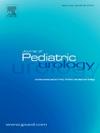Review – Renal transplantation for congenital urological diseases
IF 2
3区 医学
Q2 PEDIATRICS
引用次数: 0
Abstract
Introduction
Congenital Anomalies of the Kidney and Urinary Tract (CAKUT) are structural disorders originating prenatally and present at birth. Affecting 4.2 to 1000 per 10,000 births globally, CAKUT includes conditions like posterior urethral valves, cloacal anomalies, and reflux nephropathy. These anomalies can lead to chronic kidney disease (CKD) or end-stage kidney disease (ESKD) in children, necessitating renal replacement therapy or transplantation.
Objectives
This article aims to provide an updated perspective on pediatric kidney transplantation for children with CAKUT, emphasizing pre-transplant evaluation and management to optimize long-term outcomes.
Methods
A comprehensive urologic evaluation is essential for children with ESKD being considered for kidney transplantation. Key pre-transplant investigations include kidney/bladder ultrasound (US), voiding cystourethrogram (VCUG), uroflowmetry, and urodynamics (UDS)/video-urodynamics (VUDS). Non-operative interventions such as pharmacotherapy and clean intermittent catheterization (CIC) are also considered. Surgical interventions, like augmentation cystoplasty or continent catheterizable channels, are evaluated based on individual patient needs.
Results
Kidney/bladder US and VCUG provide essential anatomical information. UDS offers comprehensive functional data, identifying hostile bladders needing pre-transplant optimization. Non-surgical measures like anticholinergics and CIC improve bladder function, while surgical options enhance compliance and capacity. Concurrent interventions during transplantation are feasible but require careful consideration of risks and benefits.
Discussion
Children with CAKUT undergoing kidney transplantation exhibit comparable or better graft survival rates than those without CAKUT. However, those with lower urinary tract obstructions (LUTO) may have poorer long-term outcomes. UDS is crucial for evaluating bladder function pre-transplant, guiding the need for interventions. Long-term monitoring for urinary tract infections (UTIs) and bladder dysfunction is essential.
Conclusion
Optimal outcomes in pediatric kidney transplantation for CAKUT patients require thorough pre-transplant evaluation and management, particularly for those with LUTO. Multidisciplinary approaches ensure careful monitoring and timely interventions, improving graft survival and quality of life for these patients.
回顾 - 肾移植治疗先天性泌尿系统疾病
导言先天性肾脏和泌尿道畸形(CAKUT)是一种起源于产前并在出生时出现的结构性疾病。全球每 1 万名新生儿中就有 4.2 到 1000 名先天性肾脏和泌尿道畸形患者,其中包括后尿道瓣膜、泄殖腔畸形和反流性肾病等疾病。这些异常可导致儿童慢性肾脏疾病(CKD)或终末期肾脏疾病(ESKD),从而需要进行肾脏替代治疗或移植手术。本文旨在提供有关 CAKUT 儿童肾移植的最新观点,强调移植前评估和管理,以优化长期预后。移植前的主要检查包括肾脏/膀胱超声检查(US)、排尿膀胱尿道造影(VCUG)、尿流率测定和尿动力学检查(UDS)/视频尿动力学检查(VUDS)。此外,还考虑药物治疗和清洁间歇导尿术(CIC)等非手术干预措施。结果肾/膀胱 US 和 VCUG 可提供重要的解剖信息。UDS 可提供全面的功能数据,识别需要移植前优化的敌对膀胱。抗胆碱能药物和 CIC 等非手术措施可改善膀胱功能,而手术方案则可提高顺应性和容量。在移植期间同时进行干预是可行的,但需要仔细考虑风险和益处。讨论接受肾移植的 CAKUT 患儿的移植存活率与无 CAKUT 患儿相当或更高。然而,下尿路梗阻(LUTO)患儿的长期预后可能较差。UDS 对于评估移植前的膀胱功能至关重要,可指导是否需要进行干预。结论小儿肾移植的 CAKUT 患者要想获得最佳预后,需要在移植前进行全面的评估和管理,尤其是那些患有下尿路梗阻的患者。多学科方法可确保仔细监测和及时干预,从而提高这些患者的移植存活率和生活质量。
本文章由计算机程序翻译,如有差异,请以英文原文为准。
求助全文
约1分钟内获得全文
求助全文
来源期刊

Journal of Pediatric Urology
PEDIATRICS-UROLOGY & NEPHROLOGY
CiteScore
3.70
自引率
15.00%
发文量
330
审稿时长
4-8 weeks
期刊介绍:
The Journal of Pediatric Urology publishes submitted research and clinical articles relating to Pediatric Urology which have been accepted after adequate peer review.
It publishes regular articles that have been submitted after invitation, that cover the curriculum of Pediatric Urology, and enable trainee surgeons to attain theoretical competence of the sub-specialty.
It publishes regular reviews of pediatric urological articles appearing in other journals.
It publishes invited review articles by recognised experts on modern or controversial aspects of the sub-specialty.
It enables any affiliated society to advertise society events or information in the journal without charge and will publish abstracts of papers to be read at society meetings.
 求助内容:
求助内容: 应助结果提醒方式:
应助结果提醒方式:


